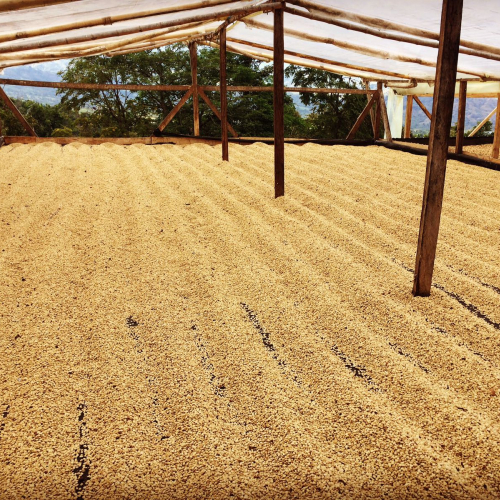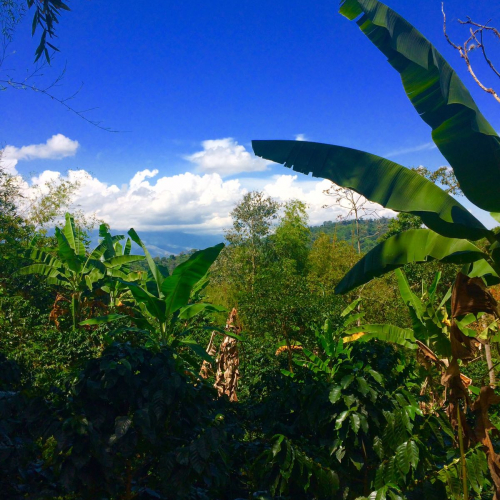Colombia
Did you know?
About
A state in northwest South America, Colombia has coastlines on the Pacific Ocean and the Caribbean Sea. Behind coastal plains lie three ranges of the Andes, separated by high valleys and plateaux. Most populated cities in Colombia are located in the center of the country and in the northern coast. To the southeast are the prairies and then the jungle of the Amazon. Colombia has a tropical climate, though temperatures vary with altitude.
The main agricultural products are coffee, sugar, bananas, cotton and flowers. For the minerals, the main production is coal, nickel, gold, silver, platinum and emeralds. Industry involves mainly processing minerals and agricultural products. Despite its wide range of agricultural products and exports, coffee is the one most linked to Colombian identity. But the local consumption is surprinsingly low for such identification.
The country is also important on the origin specification. Colombian coffee is probably the first one which comes to mind when the discussion is about high quality coffee, maybe because it was the Colombian coffee industry which had launched the idea of differentiation by quality and origin: the year was 1959. The year when Juan Valdez was born.
One of the greatest challenges on Colombian coffee production today is the logistics. Riots can easily affect the coffee transit in ports and roads.
Only Arabica
Colombian coffee one of few coffees in the world that are supplied in volume throughout the year. It is dued to the privileged location under the Equatorial line which provide ideal weather conditions.
*In some areas some Robusta experiments are being tested.
Europe and United States have historically always been by far the largest export market for Colombian coffee. This is no longer the case today because the European industry has reduced its share in their blends mostly out of price considerations and after learning how to substitute Colombian components on their blends.
Nice to know
Colombia is the largest producer of washed coffees in the world, and the third largest coffee producer worldwide after Brasil and Vietnam. Labour shortages in the coffee industry however tend to be a problem in Colombia, especially during periods with low market prices, where the labour force can easily be tempted to take up jobs in other segments.
New generations of coffee farmers are less and less interested to maintain the coffee activity. Young people is rather looking for better opportunities in the cities.
Coffee facts
Crop periods
Flowering Period |
|
| Main : From January until March | |
| Secondary : From July until September | |
Harvest Period |
|
| Main: from September until January | |
| Secondary: from April until July | |
Shipping Period |
|
| From October until September (*) | |
(*) Coffee is being exported all year round.
Transit days
| Port of Shipment | Imp. | EU | US |
| Buenaventura | 58% | 18 | 7 |
| Cartagena | 21% | 17 | 7 |
| Santa Marta | 18% | 18 | 7 |
| Barranquilla | 2% | 18 | 7 |
Destination countries
1. USA
2. Germany
3. Japan
ICO Figures
Classifications
Varieties
Main varieties used are: Castillo, Colombia and Caturra.
By Region
Traditionally, all coffees were being sold as: Armenia/Medellin Excelso. Since a few years, there is a tendency to market the coffee more often by region. Cauca, Santander, Huila, Tolima, Antioquia and Nariño have become the most demanded regions.
There are 2 distinctive crops in Colombia: Main crop and Mitaca. The timing of these crops in the different regions is not necessarily the same.
By Defect
The maximum allowed number of defects in a 500 gr sample is 12/60 (12 defects of the first group and 60 defects of the second group). Max 24 faults are allowed in 500 gr.
There are two groups of defects :
- group 1 : called primary defect
- group 2 : called secundary defect
Primary defects (defects related to cup characteristics) :
Black, moldy or sour
Secondary defects (defects related to appearance)
Discoloured (oldish, overdried, yellow, mottled), broken ('broca'), cracked, cut, insect damaged, deformed, immature, greyish or spongy.
Remark : Less defects of group 1 can be offset by more defects of group 2, with a ratio of 1 for 10.
Example1 :
You have 10 defects of group 1 and 80 defects of group 2 = 10 + (60 + ( 2 * 10 )) with a total of 90 : allowed
Example2 :
You have 9 defects of group 1 and 90 defects of group 2 = 8 + (60 + ( 3 * 10 )) with a total of 98 : allowed
Cupprofile
Coffee growing regions and their main cup characteristics
|
Guajira Magdalena Cesa |
Bitter sweet chocolate, Low acidity |
|
Bolivar |
Nutty flavor, high body and medium acidity |
|
Norte de Satander |
Chocolate notes |
|
Santander |
Tobacco notes |
|
Antioquia |
Fruity fragance, citric and sweet notes |
|
Choco |
Medium body, high acidity |
|
Caldas (PCC) Risaralda (PCC) Quindio (PCC) Valle del Cauca (PCC) |
Herbal and fruity notes, medium body and acidity |
|
Boyacá |
High acidity and sweet notes |
|
Casanare |
Mid-low acidity, high body, citric notes |
|
Cundinamarca |
Strong aroma, medium acidity and body |
|
Tolima |
High acidity, sweet fruital and citric notes |
|
Meta |
Citric notes, balanced body and acidity |
|
D.O. Cauca |
Citric, sweet and floral notes |
|
D.O. Huila |
Winey and sweet notes, medium-high acidity |
|
D.O. Nariño |
High acidity, citric and sweet notes |
|
Caquetá |
Spicy notes, low acidity and herbal aroma |
|
Putumayo |
Herbal notes, high body and medium-high acidity |
D.O. Donomination of Origin
PCC : Coffee Cultural Landscape
Processing
|
Picking |
Picking one by one by hand |
|
Washing (1) |
Fully Washed coffee |
|
Fermentation |
From 12 to 24 hours |
|
Drying |
Sun drying in the patios and mechanical drying |
|
Sorting |
Electronic sorting |
(1) About washing
A more ecological technique has recently been developed for the washing of coffee. In a traditional 'benificio', 40 liters of water are used for the washing of 1 kg green coffee. In a new ecological set-up, this is only 0.6 to 2 liters as water is being re-used. This new technique is very beneficial in ecological terms, quality-wise one has the impression that this process is not so beneficial: it might be the reason why Colombian coffees bleach so quickly nowadays.
Coffee Environment
Official body: Federación Nacional de Cafeteros de Colombia (FNC)
The FNC, is owned and controlled by Colombia's coffee farmers (Cafeteros), of whom there are more than 500.000.
The FNC plays a crucial role for the entire coffee business in Colombia, even more so because they act as regulators as well as exporters.
Until very recently the farmers were guaranteed a minimum price for an established standard quality. From time to time, this guaranteed price in pesos was adjusted to international market circumstances and thus offered a buffer against volatile and unpredictable prices. The farmers were guaranteed to have FNC as a buyer at the minimum price.
Nowadays, there is no more minimum price. Local prices are fluctuating according to the international markets. The financial aspect of this policy is managed by the Fondo Nacional Del Cafe who then uses the infrastructure of the FNC to organise the distribution of the funds to the growers.
Since 2002 the tax on coffee is paid by the coffee producer, and therefore the exporters pay a price net of taxes, which latter are collected by the Federation for the purposes pointed out by the government and the coffee growers representatives.
Coffee exported by the FNC amounts to 30% of Colombia's total coffee export. The FNC runs a large number of mills throughout the country and owns large warehouses for the storage of their coffee under the name of 'Almacafe'. They also perform a quality control in the ports on every single bag that leaves the country, including the coffee exported by private shippers.
Apart from the marketing function, the FNC plays an important role in many other domains as well : research, agronomic support and technical advices.
The FNC uses all available means of modern marketing and advertising to promote Colombian coffee around the world. The logo of 'Juan Valdez' has become familiar to people all over the world, and has created more awareness for the 'Cafe de Colombia'.
Private Exporters
Private exporters have to register all their export sales with the FNC. They also compete with the FNC to purchase their raw coffee from the growers.
The difference between the price paid to the grower and the export price does not only cover the costings and margins of the exporters, it also includes various taxes and contributions, which are subject to regular changes. This highly complex and extremely regulated pricing system makes the costing of the export extremely hazardous.



